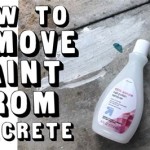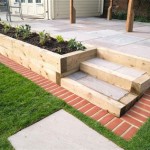How To Refresh A Concrete Patio
A concrete patio, while durable and versatile, can lose its luster over time. Exposure to the elements, foot traffic, and general wear and tear can result in a dull, stained, and even damaged surface. Refreshing a concrete patio is a worthwhile endeavor that not only improves the aesthetic appeal of the outdoor space but also extends the lifespan of the concrete itself. This article provides a comprehensive guide to the process of refreshing a concrete patio, covering essential steps and considerations.
Preparation is Key: Cleaning and Assessment
Before embarking on any refreshing project, the initial step involves thorough cleaning. This removes accumulated dirt, debris, and surface stains, providing a clean canvas for subsequent treatments. The specific cleaning method depends on the extent of soiling and the types of stains present.
For general cleaning, a stiff-bristled brush and a mixture of water and mild detergent are often sufficient. The solution should be applied to the patio surface, scrubbed vigorously, and then rinsed thoroughly with a garden hose. For more stubborn dirt and grime, a pressure washer can be employed, but caution is necessary to avoid damaging the concrete surface. Pressure should be adjusted to a moderate level and the nozzle kept at a safe distance from the concrete to prevent etching or pitting.
Following the initial cleaning, a more detailed inspection for specific stains should be conducted. Common patio stains include those caused by oil, grease, rust, mildew, and algae. Each type of stain requires a specific cleaning solution or method. Oil and grease stains can be addressed with degreasers or specialized concrete cleaners. Rust stains often respond well to oxalic acid-based cleaners. Mildew and algae can be effectively removed with bleach solutions or commercial mildew removers. It's critical to follow the manufacturer's instructions for each cleaning product and to test the solution on a small, inconspicuous area before applying it to the entire patio.
After the patio is clean and dry, a careful assessment of the concrete's condition is essential. This involves checking for cracks, chips, spalling (surface flaking), and other forms of damage. Addressing these issues is crucial before proceeding with any further treatments. Small cracks can often be filled with concrete patching compounds, while larger cracks might require more extensive repairs. Spalling should be addressed by removing the loose or damaged concrete and patching the area with a suitable concrete repair mortar. Ignoring these damages will lead to bigger problems, and more expensive repairs in the future.
Enhancing the Surface: Sealing and Staining
Once the concrete patio is clean and any necessary repairs have been completed, the next step involves enhancing the surface. This typically involves sealing the concrete to protect it from the elements and staining it to add color and aesthetic appeal. Sealing is a critical step in protecting the cleaned and repaired surface. Concrete is porous, meaning it readily absorbs water and other liquids. This absorption can lead to staining, cracking during freeze-thaw cycles, and the growth of mildew and algae. A concrete sealer creates a barrier that prevents these issues, extending the life of the patio and making it easier to clean.
There are two main types of concrete sealers: penetrating sealers and topical sealers. Penetrating sealers, such as silane or siloxane sealers, penetrate the concrete and react chemically to create a water-repellent barrier. These sealers do not change the appearance of the concrete and allow it to breathe, preventing moisture buildup within the concrete. Topical sealers, such as acrylic or epoxy sealers, form a protective film on the surface of the concrete. These sealers can provide a glossy finish and can be tinted to add color. However, they do not allow the concrete to breathe and can be prone to scratching and peeling. The choice of sealer depends on the desired appearance and the specific needs of the patio.
Before applying the sealer, the concrete surface must be clean, dry, and free of any loose debris. The sealer should be applied according to the manufacturer's instructions, typically using a roller, brush, or sprayer. Multiple coats may be necessary to achieve adequate protection. Proper ventilation is essential during the application process, and safety precautions should be taken to avoid inhaling the sealer fumes.
Staining the concrete patio is an excellent way to add color and visual interest. Concrete stains come in a variety of colors and finishes, allowing for a wide range of design options. There are two main types of concrete stains: acid-based stains and water-based stains. Acid-based stains react chemically with the concrete, creating a permanent and mottled color. These stains are known for their durability and natural-looking finish. Water-based stains, on the other hand, penetrate the concrete and deposit pigment. These stains offer a wider range of colors and are easier to apply than acid-based stains. The choice of stain depends on the desired aesthetic and the level of difficulty desired in the application process.
Prior to staining, the concrete must be thoroughly cleaned and prepared. Acid-based stains typically require a neutralizing wash after application, while water-based stains may require multiple coats to achieve the desired color intensity. It is essential to follow the manufacturer's instructions for each stain and to test the stain on a small, inconspicuous area before applying it to the entire patio.
Creative Embellishments: Patterns and Overlays
Beyond sealing and staining, creative embellishments can further enhance the appearance of a concrete patio. These embellishments can include adding patterns, textures, or overlays to create a unique and personalized outdoor space. Stenciling is a simple and cost-effective way to add patterns to a concrete patio. Stencils can be purchased in a variety of designs, ranging from simple geometric shapes to intricate patterns. The stencil is placed on the concrete surface and then painted with a concrete stain or paint. Once the paint is dry, the stencil is removed, leaving behind a crisp and defined pattern.
Another option is to use textured rollers or stamps to create a textured surface on the concrete. These rollers and stamps can be used to create patterns that mimic natural stone, brick, or other materials. The concrete is typically coated with a thin layer of overlay cement, and then the textured roller or stamp is pressed into the wet cement to create the desired pattern. Overlay systems provide another way to transform the appearance of a concrete patio. These systems involve applying a thin layer of polymer-modified concrete over the existing concrete surface. Overlays can be used to create a variety of textures, patterns, and colors. They can also be used to repair damaged or uneven concrete surfaces.
There are several types of concrete overlays, including micro toppings, stamped overlays, and self-leveling overlays. Micro toppings are thin layers of concrete used to create a smooth, seamless surface. Stamped overlays are used to create textured patterns, while self-leveling overlays are used to level uneven concrete surfaces. Applying concrete overlays requires careful preparation and attention to detail. The existing concrete surface must be thoroughly cleaned and primed to ensure proper adhesion. The overlay should be mixed and applied according to the manufacturer's instructions. Proper curing is essential to ensure that the overlay bonds properly to the existing concrete.
Another embellishment technique is adding decorative aggregates which involves embedding decorative stones, pebbles, or glass into the concrete surface. This can be done by scattering the aggregates onto the wet concrete and then pressing them into the surface. Once the concrete has cured, the surface is typically ground and polished to expose the decorative aggregates.
In summary, refreshing a concrete patio involves several key steps: thorough cleaning and assessment, sealing and staining, and creative embellishments. Each step requires careful preparation and attention to detail. By following these guidelines, it is possible to transform a dull and worn concrete patio into a beautiful and inviting outdoor space. The specific techniques and materials used will depend on the desired aesthetic and the condition of the existing concrete. Planning and preparation will ensure a successful and long-lasting result.

Resurfacing A Concrete Patio For Budget Diy Makeover Fab Everyday

Resurfacing A Concrete Patio For Budget Diy Makeover Fab Everyday

3 Concrete Resurfacing Options For Patio

Lovely Home Accents Improvement Guest Blog How To Refresh Your Old Concrete Patio

Before And After Painted Concrete Patio Thistlewood Farm

9 Great Concrete Patio Ideas For A Makeover Remodelaholic

How To Repair And Resurface Old Concrete Patios Fixing Ugly

Resurfacing A Concrete Patio For Budget Diy Makeover Fab Everyday

How To Paint A Concrete Porch Or Patio

Easy Concrete Patio Coverup Ideas The Garden Glove
Related Posts








